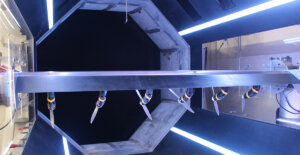
Riblets mimic v-shaped ridges found on shark skin and reduce friction and turbulence in the water and air. USC Viterbi Assistant Professor Mitul Luhar explores how to optimize riblet shape and size using an algorithm. PHOTO/ISTOCK, RAMON CARRETERO, PEXELS, JUHASZ IMRE
A lot of sharks—for example, great white and mako sharks—can move so quickly and fluidly through the ocean, they are often compared to torpedoes. As the ocean is often characterized by turbulent flow, where the fluid motion is undergoing constant changes in speed and direction that produce irregular patterns, the smoothness with which a shark can navigate these waters is even more astounding. It is for this reason so many have studied the nuances of shark skin over the last four decades, trying to identify the particular elements that might reduce drag in a turbulent flow.
A key element isolated in these studies were v-shaped ridges referred to as dermal denticles. In follow up studies, engineers developed similar surfaces called riblets. They experimented with different sizes and shapes to understand how to reduce friction and turbulence within a wall-bounded flow—a flow characterized by a smooth boundary, for example where a ship hull moves through the water or within a pipe. Such friction-reducing riblets have been used on swimsuits and hulls of the racing yachts appearing in the America’s Cup to boost performance. Motivated by the possibility of reducing fuel consumption and boosting range, riblets have also been tested on airplanes.
While manufacturing advancements like 3D printing have helped ease the cost and time-investment in creating such surfaces, computationally complex flow equations have made it difficult to further optimize riblet design.
To address this, Dr. Mitul Luhar, assistant professor of aerospace and mechanical engineering at the USC Viterbi School of Engineering, and Andrew Chavarin, a mechanical engineering Ph.D. candidate at USC Viterbi, developed an algorithm that reduces complexity and helps determine the exact shape, size and spacing of an optimal riblet design.
Said Luhar: “Depending on the specific riblet geometry being tested, this could take as little as one minute on a laptop. In other words, hundreds of geometries can be tested in a day without requiring high-performance computing capabilities.”
The algorithm works by first isolating the key building blocks of the turbulent flow field by identifying what flow features are most amplified by the equations governing fluid flow. While these equations are complex and turbulent flow fields are full of nuance, Luhar and Chavarin found that looking at just a few key building blocks can be enough to work out the riblet recommendations for the entire flow field. It turns out that the amplification of one particular flow feature is a very useful predictor of overall drag reduction.
Once this flow feature is isolated, the algorithm will propose and evaluate different riblet designs to see how they impact the flow field. High-gain elements within the field are those which contribute the most chaos to a flow field. An optimal riblet recommendation will be that which does the best job of suppressing high-gain elements, thus reducing turbulence and friction in the overall flow field.
Luhar and Chavarin focused initially on simple riblet designs to demonstrate that the algorithm can reproduce historically-validated recommendations for specific flow conditions. From here, Luhar and Chavarin seek to adapt the algorithm to develop and optimize more complex three-dimensional or multiscale geometries.
Much of the motivation comes from advances in manufacturing techniques. “Riblet geometries tested in the past were relatively simple—usually blades, rectangles or triangles and trapezoids. Additive manufacturing techniques, for example 3D printing, have enabled the fabrication of much more complex surface features and geometries,“ Luhar said. “However, testing all possible geometries in high-fidelity numerical simulations or laboratory experiments would be prohibitively time-consuming and expensive.” Instead, using the algorithm, many riblet geometries can be identified. The most promising candidates can then be included in more complex numerical simulations or laboratory experiments.

As the size of the riblet increases, high-gain elements are suppressed, resulting in a smoother overall flow. However, after the riblet reaches its optimal size, increases in riblet size have the opposite effect, emphasizing high-gain features and adding friction and turbulence in the flow field. GIF/MITUL LUHAR
In simple terms, riblets work because of their anisotropic nature: They provide much less resistance to the mean flow in the direction of motion, but block cross-flows created by turbulent eddies. In a laminar flow, fluid layers remain ordered and flow remains smooth and uninterrupted. Thus, when riblets work well, the flow in the riblet “grooves” also remains ordered and generate less friction on the wall below. Initially, friction reduction increases as riblet size increases since a larger portion of the flow field remains laminar. However, for all riblet geometries, there is an optimal size. As riblets grow beyond this size, the turbulent cross-flows start interacting with the riblets and the flow in the riblet grooves no longer remains ordered. When this happens, the riblets generate even more friction than a smooth wall would and become detrimental to performance.

With every “step” of change in the shape of the riblet, the flow field becomes more ordered. GIF/MITUL LUHAR
Luhar’s research has varied implications. First, in the laboratory experiments of the 80s and 90s, “best case” riblets led to roughly 10 percent drag reduction. A more complex riblet design could potentially reduce drag even more. But beyond drag reduction, Luhar hopes to explore what other benefits riblets can offer. “I see significant scope for developing ‘multifunctional’ surfaces that accomplish other things, for example reduce icing, noise and fouling—an accumulation of unwanted materials on a surface—as well as increase heat exchange with a minimal frictional penalty.”
This research was published in the American Institute of Aeronautics and Astronautics(AIAA) Journal. It is based on work supported by the Air Force Office of Scientific Research under award FA9550-17-1-0142 (program manager Gregg Abate).
Published on July 16th, 2019
Last updated on July 16th, 2019









